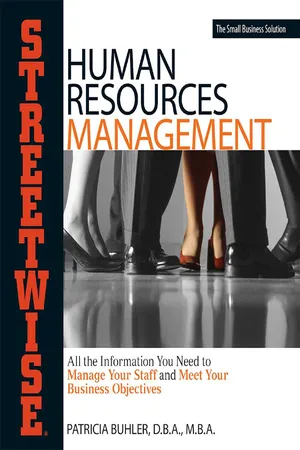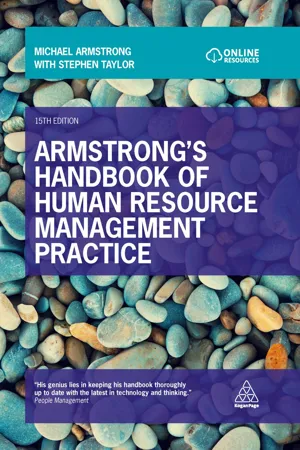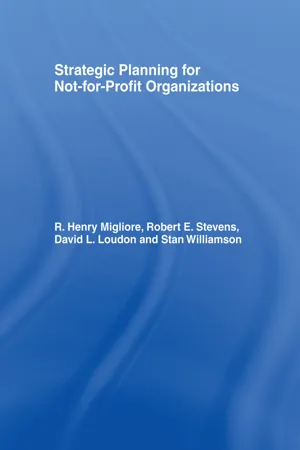Business
Human Resource Objectives
Human resource objectives refer to the specific goals and targets that an organization sets for its human resources department. These objectives typically focus on areas such as recruitment, training, performance management, and employee relations. By defining clear human resource objectives, businesses can align their workforce strategies with overall organizational goals and ensure the effective management and development of their employees.
Written by Perlego with AI-assistance
Related key terms
5 Key excerpts on "Human Resource Objectives"
- eBook - ePub
Human Resources Management
All the Information You Need to Manage Your Staff and Meet Your Business Objectives
- Patricia Buhler(Author)
- 2002(Publication Date)
- Everything(Publisher)
The overall human resource plan is driven by the company’s strategic plan. Plans are established for three different time horizons: short-term, intermediate-term, and long-term. A short-term plan traditionally covers about one year. The intermediate-term plan ranges from about two to five years. Depending on the industry within which the firm operates, the long-range plan can cover from five to twenty-five years. The shorter the time horizon is, the more specific the details of the plan are. Longer time frames tend to be somewhat more general.Determine the Human Resource ObjectivesOnce the organizational objectives are identified, it is time to develop the Human Resource Objectives. These objectives must be aligned with the organizational objectives to ensure that the overall corporate goals are met.For example, an organization may develop a growth strategy by moving into related businesses. The Human Resource Objectives must then be geared toward growth; that is, hiring, training, and promoting individuals to support this new related business.By contrast, a firm forced to engage in a retrenchment strategy will craft a very different set of Human Resource Objectives. Here, the focus will be on layoffs. As a result, the plan may include the development of a policy to determine who will be laid off, the creation of severance packages, and an examination of retraining for employees.Forecast Shortages and SurplusesA shortage or surplus must be determined for each job in the organization. Then it is time to develop specific action plans to respond to the finding. If surpluses are anticipated, the organization must plan to redirect extra employees. If shortages are forecast, individuals must either be trained or recruited to acquire the needed skills. These action plans must consider the general labor market. If shortages for the job category are also being forecast for the general labor market, the firm may have to revise its compensation and benefits packages, revise its recruitment strategies, and/or revise career development opportunities to attract this limited talent.The simplest method of determining surpluses and shortages is the transition matrix, which depicts the movement of employees through the organization. The simplest method of determining surpluses and shortages is the transition matrix, which depicts the movement of employees through the organization. The matrix helps identify trends by tracking the transition of people over time. (Numerous software programs are available to help companies with all of these tasks.) - Michael Armstrong, Stephen Taylor(Authors)
- 2020(Publication Date)
- Kogan Page(Publisher)
Dyer and Reeves (1995: 656) described HR strategies as ‘internally consistent bundles of human resource practices’, and in the words of Boxall (1996: 61) they provide ‘a framework of critical ends and means’. HR strategy was defined by Boxall and Purcell (2016: 26) as ‘the critical set of economic and socio-political choices that managers make in building and managing a workforce’. Its purpose as stated by Wright and McMahan (1999: 52) is to ‘enable an organization to achieve its goals’. These goals will include the achievement of required levels of performance – business success in a commercial organization, operational success in a not-for-profit organization.Words of wisdom HR strategy is part and parcel of a larger business model, and it fails if it does not serve the economic imperatives that are essential to that model. Boxall (2013: 59)High levels of economic or operational performance are important but so are the obligations of organizations to all their stakeholders. The standards quoted in Chapter 1 state that: ‘Stakeholders and their interests are integral to the best interests of the organization’ and stakeholders include both employees and owners. HR strategy is about people as well as organizations. It should also encompass another of the standards, namely: ‘Every organization is part of wider society and has a responsibility to respect its social contract as a corporate citizen and operate in a manner that is sustainable.’Strategic HRM as described in the previous chapter provides a conceptual background for HR strategy. But it is only a background. The reality is that strategic choice is exercised within organizations on the basis of evidence on the issues to be resolved and beliefs on the direction to be taken and not on abstract SHRM principles. In this chapter, consideration is given to the nature of HR or people strategy, approaches to the formulation of HR strategy, the processes of developing and implementing HR strategy including testing new people management practices.- Robert E Stevens, David L Loudon, R Henry Migliore, Stanley G Williamson(Authors)
- 2013(Publication Date)
- Routledge(Publisher)
2 Objectives can be defined as clear, concise written statements outlining what is to be accomplished in key areas in a certain time period, in objectively measurable terms. Objectives can be classified as routine, problem solving, innovative, team, personal, and budget performance.Objectives can be set at upper organizational levels in key result areas such as growth, finances, physical resources, staff development and attitudes. They are also needed in sub-units, departments, or divisions of an organization. Most important, all organizational objectives must be consistent. Thus, a department’s objectives should lead to accomplishing the overall organization’s goals.Objectives serve two fundamental purposes. First, they serve as a road map. Objectives are the results desired upon completion of the planning period. In the absence of objectives, no sense of direction can be attained in decision making. In planning, objectives answer one of the basic questions posed in the planning process: Where do we want to go? These objectives become the focal point for strategy decisions.Another basic purpose served by objectives is in the evaluation of performance. The objectives in the strategic plan become the yardsticks used to evaluate performance. As will be pointed out later, it is impossible to evaluate performance without some standard by which results can be compared. The objectives become the standards for evaluating performance because they are the statement of results desired by the planner.Objectives have sometimes been called the neglected area of management. In many situations there is a failure to set objectives, or the objectives which are set forth are unsound and therefore lose much of their effectiveness. To counteract this, a management tool called management by objectives (MBO) was developed. It emphasizes the need for setting objectives as a basic managerial process, prpviding coordination of activities at all levels of the organization.- eBook - ePub
- Gary Rees, Raymond French, Gary Rees, Raymond French(Authors)
- 2016(Publication Date)
- CIPD - Kogan Page(Publisher)
In understanding what HR does in an organisation it can be useful to take a historical perspective. Who actually started the HRM process in an organisation (eg a CEO deciding that due to growth of the organisation, an HR function and HR manager needed to be brought in) can provide a starting point from which to trace its subsequent development. The question of why the HR function was started (perhaps with specific goals in mind, such as identifying training gaps, dealing with increased specialist recruitment, etc) is also highly relevant. Following this, identifying key milestones in the history of the HR function may provide further understanding of how HR has evolved (eg the introduction of a performance management system). Whilst each organisation evolves in its own inimitable fashion, generic models of the goals of HRM can, nonetheless, be considered.2.5 HRM GOALS
Whilst the academic debate surrounding the defining of HRM goals continues, Boxall and Purcell (2008, p20) suggest that there are four underpinning motives in HRM:- Cost-effectiveness – maintaining stakeholder loyalty and trust is essential here, and this may mean running the business within budgetary constraints or maximising profits.
- Legitimacy – in essence, the allocation of moral legitimacy and ethical standing in society (see Chapter 4 ).
- Flexibility – in order to cope with change, organisational flexibility is vital for survival. It incorporates both short-term responsiveness and long-term agility (see Chapter 7 ).
- Autonomy – particularly managerial autonomy and the power to act. The political context may bring about change in managerial behaviour which may need some regulation in terms of corporate social responsibility.
Whilst the various goals of HR may differ across private, public and not-for-profit sectors (see Chapter 3 - eBook - ePub
Strategic Human Resource Management
An International Perspective
- Gary Rees, Paul Smith, Gary Rees, Paul Smith(Authors)
- 2021(Publication Date)
- SAGE Publications Ltd(Publisher)
2 Human Resource Management through a Strategic PerspectiveAlison Rieple, Marco Pironti, Paola Pisano and Valentina CilloChapter Overview
Defining the concept of strategy is both challenging and complicated at the same time. The strategy definition depends on the fundamental decisions about the future direction of an organization: its purpose, its resources and how it interacts with the environment in which it operates. Every aspect of the organization plays a role in this strategy: people, finance, production method, environment, customers, and so on. Moreover, changes in markets, regulations, technology, customers, competition and other factors mean that strategy formulation and implementation is an ongoing process that can be judged only from a historical perspective in the context of the organization's past events, resources and experience. In this chapter, we would like to analyse a new trend of modern strategies. Starting from the meaning of strategy and its definition, the authors will introduce the general formulation and implementation of strategies within the organization and the new framework that the organization has to consider to manage national and global strategies. The chapter will focus on the role of strategic human resource management (SHRM). As outlined in Chapter 1, SHRM involves a future-oriented process of implementing HR programs that address business problems and directly contribute to major long-term business objectives (Delery and Roumpi, 2017). SHRM covers the overall HR strategies adopted by business units and companies and tries to measure their impacts on performance (Lengnick-Hall et al., 2009). Several authors (Vrontis et al., 2017; Papa et al., 2018; Caputo et al., 2019) have asserted that strategy should fit with three generic conceptual variables: HRM practices, employee skills and employee behaviours. Soft skills used to be frequently described as a set of skills that most management scholars consider important in any work environment (Robles, 2012). Soft skills are connected with communication and interpersonal skills. Scientific articles analysed the managerial role of soft skills from several perspectives (Andrews and Higson, 2008; Laker and Powell, 2011; Del Giudice et al., 2017a).
Index pages curate the most relevant extracts from our library of academic textbooks. They’ve been created using an in-house natural language model (NLM), each adding context and meaning to key research topics.




